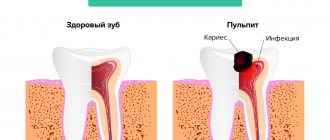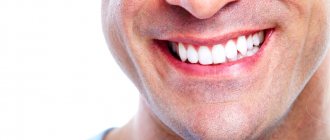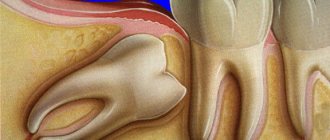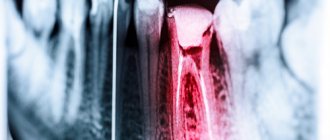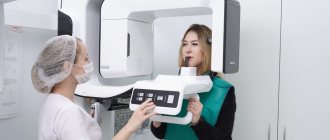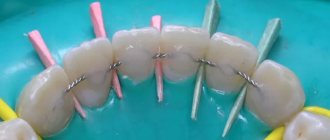Causes of denticles
The exact reasons have not yet been established, since this dental phenomenon has not yet been fully studied. It is assumed that the appearance of denticles can be accompanied by various injuries to the dentition, functional inactivity of the tooth, and injuries received during its preparation.
The following factors can provoke the development of mineralized deposits:
- inflammatory processes in the pulp;
- poor quality dental treatment;
- impaired metabolism in the pulp and periodontal tissues;
- age-related changes in tooth and gum tissues;
- endocrine diseases.
Often, the development of denticles is promoted by hormonal disorders, diabetes mellitus, hypertension, severe infectious diseases and lack of minerals.
“Fluid” symptoms
Making a diagnosis is difficult because its manifestations are extremely similar to trigeminal neuralgia. In which the main node is located in the temporal lobe near the top of the ear. And it spreads with one branch in the undereye, the second to the nose, and the third - under the cut of the lower jaw, just where the roots of the teeth are. And the picture of pain is extremely similar to dental pain. Only the rarity of the disease (1 case in 15,000) suggests trigeminal neuralgia as a last resort.
Most often, the first diagnosis will still be an exacerbation of chronic pulpitis. But knowing the results of statistics, the doctor always keeps in mind the possibility of pulpitis occurring in a concremental form. The overall percentage of cases of this form reaches 39-54% in older people (over 40) and approximately 5% in children under 16 years of age. The numbers are not comparable to cases of inflammation of the trigeminal nerve.
Clinical picture
Most often, the clinical picture of the development of the disease looks like this:
- Gradual increase in pain along the location of all three branches of the trigeminal nerve.
- Long lasting pain.
- An increase in pain at night, despite the fact that the pain does not seem to be provoked by anything (they did not eat cold or hot, sour or sweet).
- Increasing pain after chewing solid food.
- Unprovoked surges of pain with a slow decrease.
- Manifestations of lacrimation and strong salivation.
- A feeling of heaviness and a foreign object in the gum under the sore tooth.
It is difficult to diagnose this form of pulpitis, no matter what stage of development of the process it is at. The presence of such a disease is revealed as a result of a survey, a history study, or after an X-ray examination of the oral cavity.
X-rays could have been taken for a completely different reason (root removal, prosthetics, etc.). Although most often the patient comes to the doctor as a result of the fact that he is tired of constant pain.
Features of the disease
The denticles themselves do not cause discomfort unless they compress the nerve endings of the pulp. Due to their small size, they can be almost invisible. Sometimes, during development, denticles fuse with each other, then they can be detected on an x-ray. If left untreated, denticles grow uncontrollably and fill the entire pulp chamber, making further dental treatment impossible. Due to such fused formations, root canal treatment becomes problematic, and in such cases the patient is recommended to have the tooth removed.
Diagnostics
Because the disease occurs without obvious symptoms, stones are discovered by chance. If they compress the fibers of the nerve endings, then the patient feels discomfort, dull pain, heaviness in the jaw. Dentals are examined using x-rays. Small stones may not be noticed. When the formations grow together, they are clearly visible in the picture. In such cases, pain may occasionally occur when touching the crown. As mineralized deposits increase, soreness increases, especially during winter cold, and disappears in summer.
Mineralization can even be detected in embryos. True, according to statistics, children under 16 years of age rarely have such a pathology. It can be detected when the unit is depulped. On an x-ray, the dentist sees multiple or single dense shadows from the inclusions, which have a round or irregular shape. If the denticles are loose, moving them can cause pain. As a rule, in such cases, patients accurately identify the causal unit. And with acute pulpitis, the spread of pain is more extensive, radiating to the trigeminal nerve. There are situations when a patient is prescribed histology. The problem should be dealt with immediately after it is discovered to prevent a negative impact on the pulp.
Classification of denticles
Depending on their location, denticles are:
- Free (most often found directly in the pulp tissue, in isolation; if dentin is formed intensively, they grow together with the inner walls of the tooth, becoming parietal denticles);
- Adjacent, or interstitial (initially based at the inner walls of the tooth cavity).
Depending on the structure, denticles are divided into two groups:
True denticles are synthesized directly on the pulp tissue. The formations are similar in structure to dentin and have dentinal tubules. They are localized mainly at the top of the root canal. They are quite rare.
False denticles form independently as a result of necrosis of adjacent tissues. They do not have a dentin-like structure and tubules.
Regardless of the type of denticles, it is necessary to get rid of the problem as soon as it was discovered, since this can negatively affect the condition of the pulp of the diseased tooth.
Mineralized dental pulp structures have different genesis and structure; pulp calcifications are usually found and designated. In the ICD they relate more to section K04.2 Pulp degeneration. Denticles, pulp petrification, not to section K04.3 Incorrect formation of hard tissues in the pulp.
Calcifications come in several sizes (microscopic and macroscopic, occupying almost the entire tooth cavity). There may be different types of mineralized structures: round or oval, smooth and indefinitely shaped, rough. The composition of their matrix: collagen fibers with hydroxyapatite crystals.
There is an opinion that the cause of the formation of petrification in the pulp is bacteria, for example, Nanobacterium
Sanguine-urn
(Ciftcioglu N., Kajander O., 1998; Ciftcioglu N. et al., 1998). Experimental studies have shown that nanobacteria may also participate in the formation of petrificates (Kajander O. et al., 1998).
Pulp tissue can transform its cells into odontoblast-like cells and form denticles (Moss-Salentijn L., Klyvert M. 1983). Dental pulp has high collagen-producing activity of fibroblasts and alkaline phosphatase, which can lead to the initiation of calcification (Tsuka-moto Y. et al., 1992; Yokose S. et al., 2000). Mineralized pulp structures of different genesis and structure are calcified structures or calcifications of the dental pulp. Foreign researchers often use the terms “stones” or “pulp stones”, which combine concepts such as petrificates and denticles.
Denticles are single or multiple dentin-like formations of round or irregular shape, up to 2-3 mm in size, sometimes, forming conglomerates, they can cause obliteration of the tooth cavity, the lumen of the root canal system (Mamedova F.M., Krakhmalev V.A., 1988; Bykov V. .L., 1998). Denticles can be a type of tertiary dentin, as a reaction to tissue damage - a defect in the carious process in response to pathological abrasion, etc., chewing overload on the tooth, which is considered as a manifestation of the protective reaction of the pulp (Bjorndal L., Mjor I., 2001; Tziafas D., 2004).
Hereditary congenital disorders during the formation of hard dental tissues may be accompanied by the presence of calcifications in the pulp. Imperfect dentinogenesis (dentinogenesis imperfecta) leads to the fact that the entire tooth cavity can be filled with denticles; Capdepont dysplasia (Stanton-Capdepont syndrome) leads to a narrowing and reduction in the volume of the tooth cavity and root canals with the presence of denticles (calcifications); obliteration of the tooth cavity can be observed with marble disease (Grosikov M.I., 1985; Kalk W., Batenburg R., Vissink A., 1998; Collins M. et al. 1999; Brenneise C., Conway K., 1999; Shankly P., Mackie I., Sloan P., 1999).
Dentin-like tissue can develop after trauma: M. Borum, J. Andreasen (1998) reported that obliteration in the long term develops in the primary incisors of 36% of teeth; the development of petrification after trauma in both primary and permanent teeth was reported by I. Heling et al. (2000). With various dislocations, as well as root fractures, the formation of petrificates and denticles occurs, and the development of internal resorption is also possible (Sekletov G.A., Sekletov A.G., 2000). Other factors in the development of pulp calcifications are also possible: the presence of a metal filling; preparing a tooth for a crown; orthodontic “load” on the tooth; metabolic disorders; systemic therapy with glucocorticosteroids; hypervitaminosis D; thyrotoxicosis; age-related changes, etc.
In terms of their chemical composition, denticles are similar to dentin and in areas of pulp mineralization, the main mineral component is brushite (Kodaka T. et al., 1998). It is known that they contain calcium 32.1%, phosphorus 14.7%, and the Ca/P ratio is 2.19, fluorine ions up to 0.88%, sodium 0.75%, magnesium 0.51%, potassium ions , chlorine, manganese, zinc and iron are present in very low concentrations (LeMay O., Kaqueler J., 1991). Free-lying denticles are completely surrounded by pulp, parietal ones are attached to the wall of the pulp chamber, interstitial ones are immersed in dentin and can be found in studies on polished sections of teeth (Kononovich E.F., 1965; Bykov V.L., 1998; Kovalevsky A.M. , Iordanishvili A.K., 2001). False denticles are formed due to poorly differentiated cells located in the adventitia of blood vessels. The differentiation of low-organized denticles stops at the stage of preodontoblasts, deposited around dead cells, and they do not contain dentinal tubules (Cohen S, Burns R., 2000).
The prevalence of denticles is observed at the age of 31-40 years and reaches 58.6% of all teeth (Al-Hadi Hamasha A., Darwazeh A., 1998). Denticles were detected in not yet erupted primary and permanent teeth, as well as in embryos; the dynamics of the development of the petrification focus in the dental pulp depends on the recurrent disorganization of the connective tissue of the pulp (Cohen S., Burns R., 2000). Denticles in the dental pulp were detected in 53.3% of elderly patients (Vakhromeeva E.N., 2008). Prevalence of calcifications in primary molars A. Arys et al. (1993) detected using microradiography and light optical microscopy in 95% of primary molars.
There is also the concept of “petrification” - focal or diffuse deposition (salt degeneration) of mineral salts along the vessels or in the focus of inflammation, when they are not utilized by the body and precipitate (Ivanov BC, 1990, Dard M., 1988). A number of physiological and biochemical processes take place when a number of proteins take part in mineralization: apolipoproteins, glycoproteins, fibrin, type 3 matrix proteinases, osteonectin, osteopontin, which are connected to each other and the atherosclerotic plaque using the enzyme transglutaminase and settle on this protein matrix carbonate and calcium (Bini A. et al., 1996; Ciftcioglu N. et al., 2003).
Histological studies have established that the process of petrification proceeds quickly and can have multidirectional outgrowths, and large petrifications were already observed in baby teeth in children; in adults they were sometimes accompanied by complete obliteration of the pulp chamber (Shaida L.P. et al., 2002). Histological studies of pulp extracted from 7,000 extracted teeth of patients found that pulp calcifications occurred in 84% of cases, and in women they occurred in 83% of cases, and in men - in 83.5%. However, in 73.6% of cases, calcifications were found in the pulp of the teeth of the lower jaw (Olivares N., Ovalle S., 2001).
Consequently, the data show that pulp calcification of both primary and permanent teeth is frequently found, and the causes of calcification vary in extent. This pathology can lead to the development of ischemia and necrosis of the pulp. Of course, this complicates endodontic treatment.
Clinic, diagnosis and tactics of root canal preparation in the presence of pulp calcifications.
Pulp calcifications develop asymptomatically and are detected only radiographically. Clinical manifestations of the presence of calcifications in the pulp are usually absent. At the same time, the presence of denticles and other mineralized structures in the pulp can lead to severe pain (Stajer AL, Kokai LE, 1997; Kovalevsky A.M., Iordanishvili A.K., 2001). Externally, upon examination, there may be changes in the color of the tooth crown (Robertson A., Andreasen FM, Bergenholtz G. et al., 1996, 1998; West JD, 1997; Robertson A., 1998). If the dental pulp is calcified, X-ray examinations can be performed and the tooth cavity can be seen to be reduced in size. Most often, the location of calcifications is found in the coronal pulp, orifices and apical part of the root canals.
Endodontic treatment of teeth in the presence of pulp calcifications involves its devitalization; detection and opening of the tooth cavity, taking into account the changed topography, access to the mouths of the root canals; preparation and high-quality removal of petrificates and the pulp tissue itself, often using ultrasonic methods; traditional irrigation of the canal system using sodium hypochlorite solution, EDTA. It is important to ensure the prevention of complications during endodontic treatment of teeth containing pulp calcifications: work under optical magnification; use of modern burs and files of endodontic systems, ultrasonic tips; removing the risk of perforation of the crown and root of the tooth; inadequate removal of pulp tissue; poor-quality filling of the canal system; elimination of factors contributing to the development of the infectious process in the periodontium. When performing endodontic treatment of a tooth with petrificate in the pulp, it is important to completely remove it; sometimes it is permissible to “bypass” the denticle with an instrument along its border with the walls of the tooth cavity under careful visual control. Denticle, as a rule, differs in color from the dentin of the walls of the tooth cavity and is distinguished by its transparency, gray-blue tint, and there are dark, intensely yellow petrificates. If a denticle is detected in the mouth and/or the root canal itself, the use of demineralizing liquids helps clean the root canals. Petrification present in the canal can be bypassed with endodontic nickel-titanium files of modern systems. It is also possible to remove denticles in the canals, including the apical part of the root, using laser technologies. In this case, it is important to bring the light guide of the laser unit or the working part of the ultrasonic nozzle into contact with the denticle, then use the instrument to fragment the pulp stone. In rare cases where it is impossible to remove the obstruction, hemisection or tooth extraction is permissible.
Accordingly, compliance with diagnostic rules and the use of modern technologies will improve the quality of endodontic treatment in the presence of dental pulp calcifications.
The structure of the dental pulp –
Speaking about the structure of the dental pulp, we will first analyze its structural elements - after which we will move on to a description of its layers, which you could see in Fig. 2. You can see the appearance of the pulp removed from the tooth (wound on a pulp extractor) in the photo below.
Video of tooth pulp removal (pulpectomy) –
1) Structural elements of pulp –
The pulp consists of loose fibrous connective tissue (with a large number of nerve endings, blood and lymphatic vessels). Accordingly, its structure will consist of collagen fibers, the main amorphous substance, as well as a large number of various cellular elements. The total collagen content is from 25 to 30% of the dry mass of the dental pulp, and it is mainly collagen types I and III. In the coronal part of the pulp, collagen fibers are located more loosely, but in its root part they form denser clusters.
As for the main amorphous substance located between the collagen fibers, it consists of water, glycosaminoglycans, as well as glycoproteins and proteoglycans. The intercellular substance has a high ability to diffusion, which allows nutrients from the blood to enter the cellular elements, and metabolic products to be excreted into the venous circulatory system. There is also a wide variety of cellular elements in the pulp - primarily odontoblasts and fibroblasts (fibroblasts are responsible for the formation of intercellular substance and the synthesis of collagen fibrils), as well as dendritic cells, macrophages, lymphocytes, mast cells, etc.
Cellular elements of the pulp -
| Cells | Odontoblasts – form dentin and provide its trophism. Neighboring odontoblasts are interconnected by intercellular connections, which allows the layer of odontoblasts to also perform a barrier function (regulating the movement of molecules and ions between the pulp and predentin). Some authors call these cells “dentinoblasts.” |
| Fibroblasts are the most numerous cells in the pulp (their number decreases with age). Their function is to produce and maintain the composition of the intercellular substance of the pulp, as well as to absorb and digest the components of the intercellular substance. | |
| Macrophages - participate in the renewal of the cellular composition of the pulp, capturing and digesting dead cells and components of the intercellular substance. They phagocytose microorganisms and participate in the development of immune reactions as antigen-presenting effector cells. | |
| Dendritic cells – they are antigen-presenting cells whose function is to absorb various antigens, process them and present them to lymphocytes. They also induce the proliferation of T lymphocytes. The content of dendritic cells increases as the pulp matures, as well as with antigenic stimulation. | |
| T-lymphocytes are contained in the pulp in small quantities, but during inflammation their number increases sharply (of all types of this population of lymphocytes, T-suppressors predominate in the pulp). B-lymphocytes are not normally found in the pulp, and appear only when it is inflamed (they synthesize IgG immunoglobulins and provide humoral immune responses). | |
| Mast cells – they are located around blood vessels; are characterized by the presence in the cytoplasm of a large number of granules with biologically active substances (histamine, heparin, eosinophilic chemotactic factor, etc.). The release of these components causes an increase in vascular permeability. | |
| Poorly differentiated cells - can give rise to odontoblasts and fibroblasts. The content of these cells decreases markedly with age. | |
| Fibers and glycoproteins | Type I and III collagen fibers, reticular fibers, fibronectin. |
| Basic intercellular substance | Glycosaminoglycans, chondroitin, proteoglycan. |
Symptoms and most common causes
The vast majority of cases of concremental pulpitis lie not only in advanced caries. The trigger for the appearance is also the erasure of the enamel, which occurs most often in people over thirty years of age. This phenomenon is often associated with bruxitis - a spontaneous convulsive clenching of the jaws, accompanied by grinding of teeth.
And another reason is impact injuries to the teeth from a fall, a fight, or careless consumption of food with hard fragments.
Although calculus pulpitis most often affects chewing molars, this is not a prerequisite. Sometimes it manifests itself in such a form as:
- Pain in the nose area with damage to the upper canines (“eye teeth”).
- Chin pain, when the lower canines and incisors are disturbed.
- Pain in the upper incisors, or infraorbital.
- Ear – pain in the molars, usually the lower jaw, although they also occur in the upper jaw.
- Temporal – with pain in the area of the roots of the sixth and eighth teeth.
Also, during attacks of pain with this type of pulpitis, there are no signs of irritation of the autonomic nervous system. True, it may be that a tooth with stones acts as a catalyst for triggering inflammation of the trigeminal nerve. By analogy with the impact of solid food on a tooth, percussion of the tooth can also cause pain.
Diagnostics
On the obtained x-ray images, areas of calcareous degeneration look like pale blurry spots, so even the presence of images gives reason not to identify concremental pulpitis 100%. Confident recognition will be helped
- The very presence of denticles after opening the caries.
- Their concentration is along the neurovascular bundles.
How fluoroscopy can definitely help is to completely exclude inflammation of the trigeminal nerve. If we compare photographs of patients with concremental pulpitis and with inflammation of the trigeminal nerve, then in the former, denticles in the dental cavity and obliteration of the root canals will be visible. And for the second, the image will show a complete absence of changes in intact teeth.
This type of pulpitis can occur not only on previously injured teeth, but also as a result of improperly treated caries. Or fillings were used from not the highest quality material, which over time lost its solidity.
